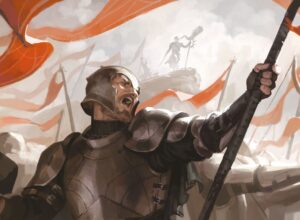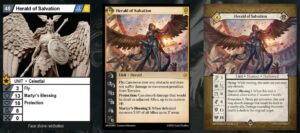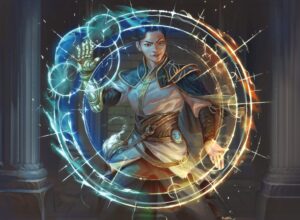May 29, 2025
Malediction – Coding For Human Processors
by Pettersen L.
May 29, 2025
Malediction – Coding For Human Processors
by Pettersen L.

Malediction is a game that emerged from a deceptively simple desire: blending the depth of interactions and customization from competitive card games with the incredible models and physical aspects of a miniatures wargame. This came with the considerable challenge of merging two game genres known for having elaborate rules, with wargames, in particular, being famous for their long gameplay sessions. The final product, however, was a passion project that has been getting a lot of praise at major board gaming conventions for being fast-paced and easy to learn without sacrificing depth. In this weirdly named blog post, we explore some of the solutions behind these positive reactions.
In the beginning, there were rules… A lot of them

While the early days of miniature gaming had a lot more going on, I like to picture a group of friends trying to bring their plastic toys to life by creating a list of rules on how they should behave. The more elaborate the situations, the longer this list would get. This increase in complexity is often a result of trying to emulate reality through a set of instructions, and it is something that connects directly to the actual birth of wargaming, as these games aimed to model real warfare, often at the expense of playability.
The actual reason creeping complexity takes such a toll on us, though, has a lot to do with how we learn and process information—a topic of great interest in cognitive psychology and one that often leads to interesting comparisons between the human brain and computers. It shouldn’t come as a surprise that so many board game designers with a background in digital games like to compare writing rules to actual coding.
So, what does a human processor look like?
In the Von Neumann architecture of a typical computer, data is stored in dedicated memory locations, with operations processed one at a time and scheduled according to a central clock. On the other hand, our brains are highly parallel systems that integrate memory and processing, storing information by strengthening neural connections linked to actions with positive outcomes. While this may seem unreliable when remembering things, it is part of what makes us such incredible learning machines. It means that we get better at things the more we do them. If that is the case, then what are we trying to optimize for when writing rules for humans?
Managing cognitive load
Be it the shape of a chess piece or the text on a card, all games communicate information somehow, and rules are our instructions to make sense of that. But unlike a computer spewing error logs and beeping when something goes wrong, humans can decide that the answer to 1+1 is “fish” and keep a game going. What I mean by this is that we can be pretty unpredictable when interpreting information.

Before our brains can commit what we learn to the back of our minds to make performing tasks second nature, information must go through what cognitive psychologists call working memory—the processing power we manage when writing instructions for humans. In the late 1980s, Professor John Sweller coined “cognitive load” to describe the mental effort used as we learn something.
Throughout the development of our Malediction, we’ve stumbled across interesting solutions for creating an engaging and intuitive experience while doing our best to deal with cognitive load. Let’s take a look at some of these solutions, shall we?
1- Reduce upfront information
This one is somewhat tricky for a miniatures game, but if you want depth in your system while still keeping things beginner-friendly, figuring out solutions for reducing how much information players need to know upfront helps greatly. This is pretty much like increasing the difficulty level as players get better at your game, a proven concept for adding depth that is as old as jumping on turtles’ heads and getting magic mushrooms. The bottom line is your game should scale up in complexity, not down.
In nearly all miniature wargames that I got to play, units already start on the board, meaning you are required to know all the rules for whatever you are bringing and the abilities for everything in your opponent’s army. This can be intimidating, and we’ve decided to do away with it.

On Malediction, you deploy units by spending echo, a resource you gain increasing amounts of at every round. This helped us control how many units we ideally wanted on the battlefield early on, allowing players to bring more stuff as the game progressed. By doing this, players only needed to worry about units’ abilities as they came into play, breaking things down into more digestible chunks of information, which brings us to our next topic!
2 – Break down complicated problems
In his Master Class about mathematical thinking, Terrence Tao shares a valuable solution for tackling complex problems: Breaking things down into more straightforward steps and solving one thing at a time. In wargames, players take turns using all their troops at once or one at a time, alternating with opponents.
We opted for the latter approach for reasons unrelated to cognitive load, like aiming for fair and more dynamic turns, but this is a good way to reduce how much stuff you need to think about at once. With alternate activations, the game becomes less tiring, and you can plan your actions as the round goes, seeing what your opponent will do and reacting accordingly.
3 – Simplify whenever possible!
A game system must only be as complex as necessary, which applies even to something as simple as the numbers on the cards. We’ve started Malediction with some pretty large values to indicate the cost of our cards, and we justified that by convincing ourselves those were placeholder values and that we needed the variance for balancing and steps like the initiative bid, where players lay down a card facedown and try to get the initiative based on the card’s cost. At some point, I even coded an app to help players keep track of their resources, as they were taking too long thinking about how many units they could afford instead of deploying them onto the battlefield.

Ultimately, we went with a cost range of 1 to 10 and embraced the challenge of making everything else work as intended. The smaller numbers eliminated the need for the app and provided a familiar and easy scale for players to gauge how strong a unit was.
4 – Tone down the tracking
Constantly asking players to remember steps they’ve taken takes a toll on working memory, which is why there is often no way around having components to track your resources. These components are a powerful tool to avoid asking them to remember stuff. Still, they should be reserved for things that are essential or largely prevalent in your game, as they come with an actual cost in plastic or paper to be manufactured.
For Malediction, we couldn’t justify having tokens to keep track of unit states as a core mechanism for status effects or how many times you used an ability. Because of that, we ensured that whenever we needed players to remember something like how many action points they’ve spent, it would only be for the duration of a unit’s turn, something short and easy to keep track of.
5 – Embrace abstraction
Action points, mastery, echo… These in-game resources and terms are all examples of abstract concepts for things we are trying to simulate. Chess is a fantastic example, where the movement of the pieces is all in favor of the strategy and fun of the game, and makes no sense as a realistic representation of warfare. Still, in wargames, the feeling of giving life to the character models is essential, meaning you have to decide what you want to simulate and what you can leave to the fantasy that players create in their minds.

In Malediction, players already had a lot to focus on with the card interactions and unit abilities, so we eliminated complex 3D physics and elaborate cover systems in favor of a more straightforward approach to movement, where obstacles simply blocked movement and line of sight.
6 – Build upon familiar concepts
We’ve established that humans are way better and faster at executing tasks once the concepts are familiar. This means you can often get a head start by building upon ideas familiar to your game’s audience. On Malediction, our references were games like Magic: The Gathering, D&D, and Warhammer, and given their popularity, this helps a ton with cognitive load for any mechanics, or even character archetypes reminiscent of those games.
There is a downside to this: you may have to jump through some hoops explaining concepts that remind people of something they’ve seen but work differently in your game. In the end, references are just a starting point, so give extra attention to what makes your game special.
7- Give players a head start!

Regardless of how simple or complicated a game is, showcasing the mechanics on social media in small bits while also aiming to provide actual gameplay content through partners or as a marketing strategy is not only a great to show confidence in your product and sell the fantasy of the game, it helps educate your audience so that they already jump into it with some background. Another good way to get players to the fun faster is to develop a simplified quickplay version of your game before you give them the whole experience. This was very useful for us at events! I also cannot overstate how much an engaged community helps spread the word on how the rules work, making things super welcoming for newcomers.
The bottom line is… Let’s aim for elegant solutions!
I could go on about things I appreciate about game systems or that I think we did well, but in the end, a lot of what we’ve discussed here are just strategies for handling complexity.

Stephen Hawking proposes that a model is elegant if it can solve complex problems without relying on too many arbitrary elements, and the same can be applied to games. Let’s boil this down to a simple mantra, shall we? A game system is elegant if it can solve complex problems simply. Our human processors would be happy with that.